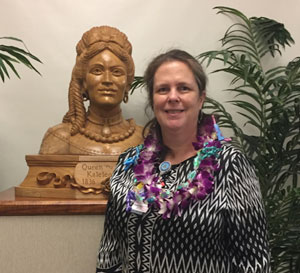Improving safety and quality of care for patients
 Hospital patients face a barrage of tests and procedures, and they meet with numerous health professionals from many departments. But who makes sure that patients are kept safe and receive high quality care throughout all of the ups and downs of their hospital stay?
Hospital patients face a barrage of tests and procedures, and they meet with numerous health professionals from many departments. But who makes sure that patients are kept safe and receive high quality care throughout all of the ups and downs of their hospital stay?
Eleanor Huey does. Huey earned her Master of Public Health (MPH) in Social and Behavioral Health Sciences from the University of Hawai‘i at Mānoa in 2010. In her current role as Manager of Quality and Patient Safety at The Queen’s Medical Center in Honolulu, Huey spends her days working to improve the safety measures that protect patients.
“It is our kuleana to improve the quality of care that patients receive,” Huey says.
Huey has long been drawn to the planning and management aspects of health care. Early in her career, she worked in quality improvement at Memorial-Sloan Kettering Medical Center in New York City. After moving to Hawai‘i in 1997, she began working at Queen’s and enrolled in the public health program at UH. She holds a lofty vision for improving health care in Hawai‘i and is always on the lookout for practical solutions.
“I am particularly interested in developing insights into clinician behavior in the hospital,” she says. She works to find ways to help clinicians become more effective, and more reliable.
To do this, Huey applies the ideas and values of public health to the practice of caring for patients. For example, during her MPH practicum placement with the Wai‘anae Coast Comprehensive Health Center, Huey noticed that people in the nearby beach communities were at risk of developing skin infections after getting small nicks or cuts. Hawai‘i has high presence of drug resistant staphylococcus aureus in communities. She worked with the Wai‘anae Coast health outreach program to distribute wound care kits with labels of signs and symptoms of skin infections, how to prevent them, and how to get treatment. The intervention was not only extremely practical, but also it had a direct impact on the health of the community.
One of her proudest accomplishments is serving as the chair of the Hawai‘i State Patient Safety Task Force, which formed at a time of growing nationwide attention on the impact of medical errors. Under Huey’s leadership, the group implemented harm prevention and mitigation strategies across the continuum of care in the state. One example was the development and distribution of a universal medication wallet card for patients.
Over the years, she has learned that the key to improving safety and quality for patients is developing trust between health care workers, Huey says. “People who are working to keep patients safe need an internal bond of trust so they can work towards their common goal.”
“Such trust emerges when team members support each other’s clinical work, and when the health care facility maintains its ties with the soul of the community that it serves,” Huey says.
In her work, her steadfast commitments to accountability and persistence mingle with the exhilaration she feels from working as part of a dedicated team. Huey is inspired by working with her team to help the most vulnerable populations in our community. She loves knowing that her team makes a difference, somewhere in the hospital system, every day.
